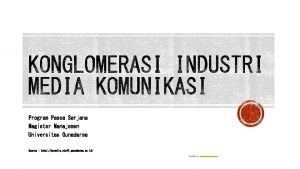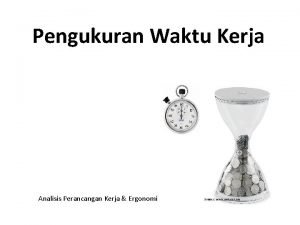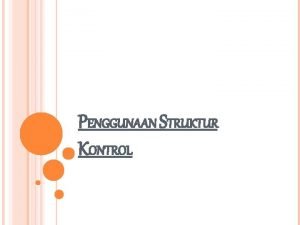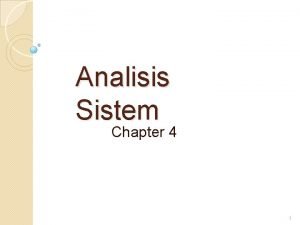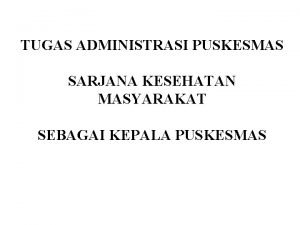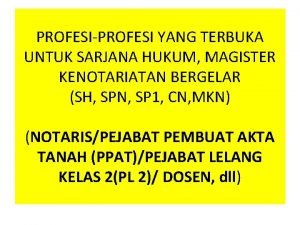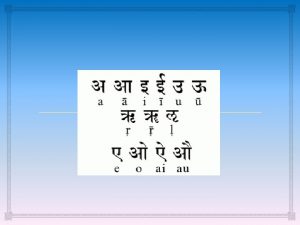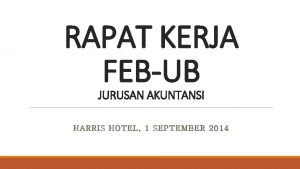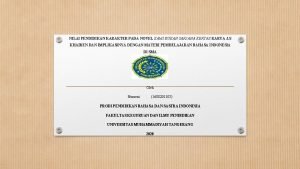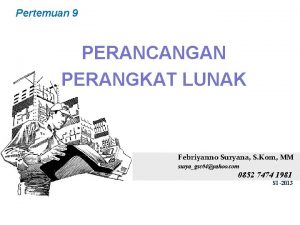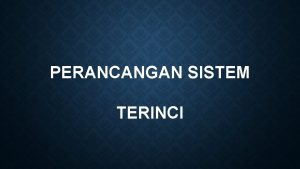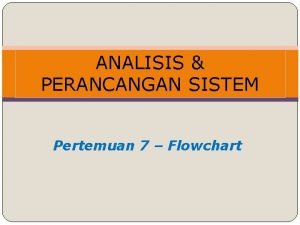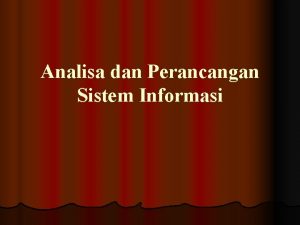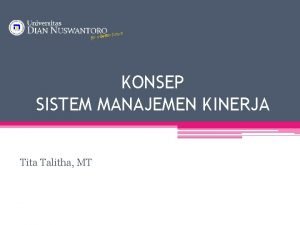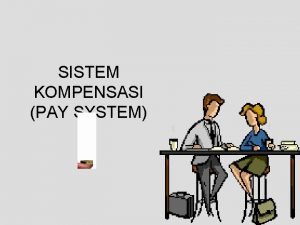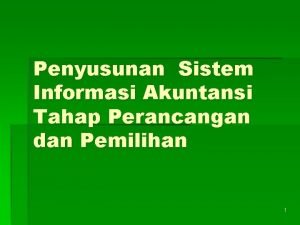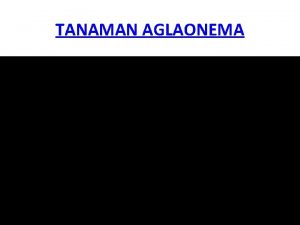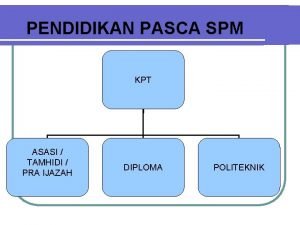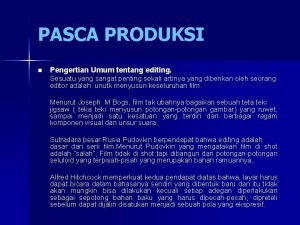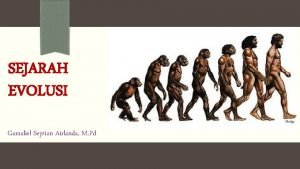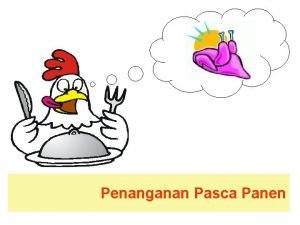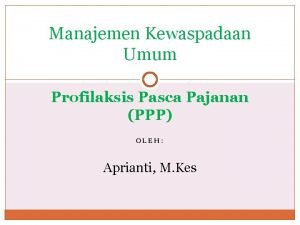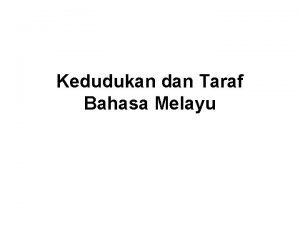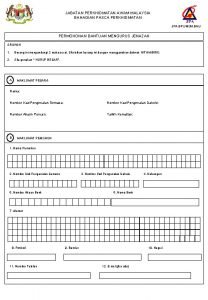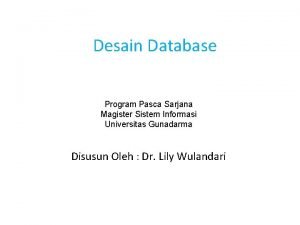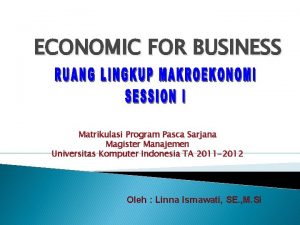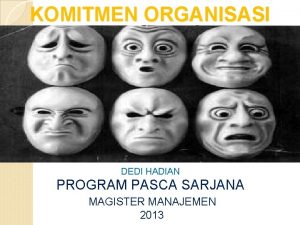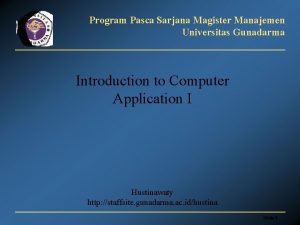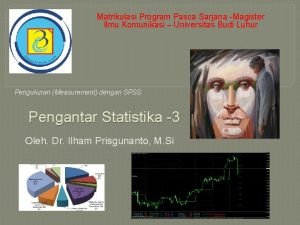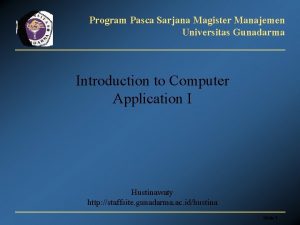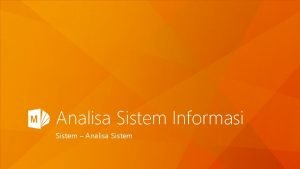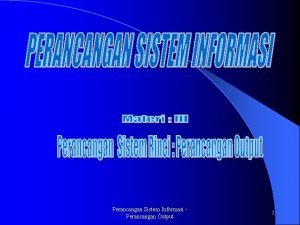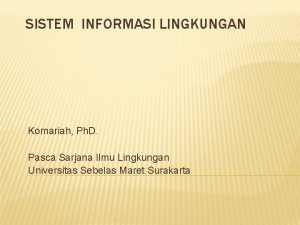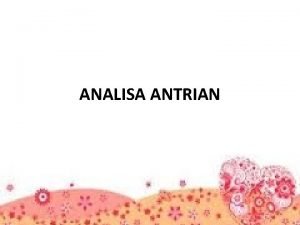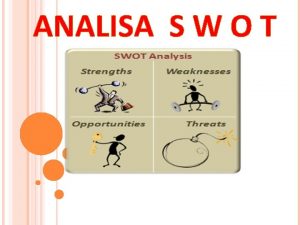ANALISA PERANCANGAN SISTEM Program Pasca Sarjana Magister Sistem




























- Slides: 28

ANALISA & PERANCANGAN SISTEM Program Pasca Sarjana Magister Sistem Informasi Universitas Gunadarma Disusun Oleh : Dr. Lily Wulandari

Systems Analysis • • System Development Life Cycle Planning Phase Analysis Phase Documentation Tools

System Development Life Cycle

Planning Phase • Create a Project Development Plan • Project management software • Joint application design (JAD)

Planning Phase • Graphical project planning – PERT (Program Evaluation and Review Technique) – WBS (Work Breakdown Structure) – Gantt chart

Planning Phase

Planning Phase

Planning Phase

Analysis Phase • Produce a list of requirements for a new or revised information system • Analysis phase activities –Study the current system –Determine system requirements –Write requirements report • System requirements are the criteria for successfully solving problems identified in an information system –Success factors

Documentation Tools • The core documentation tool for project teams using structured methodology is the data flow diagram (DFD) –External entity –Data store –Process –Data flow

Documentation Tools

Documentation Tools • The current standard for object-oriented documentation is called UML (Unified Modeling Language) • A use case diagram documents the users of an information system and the functions they perform –Actors • A class diagram provides the name of each object, a list of each object’s attributes, a list of methods, and an indication of the cardinality between objects • A sequence diagram depicts the detailed sequence of interactions that take place for a use case

Documentation Tools • CASE (Computer Aided Software Engineering) tools help project team members manage all the details of system documentation. In this example, the project team is developing a course registration system. The top screen shows how the CASE tool helps developers create a complete specification by pointing out missing elements in the design. The second screen shows how the CASE tool generates program code.

System Design • Design Phase • Evaluation and Selection • Application Specifications

Design Phase • The project team must figure out how the new system will fulfill the requirements specified in the System Requirements Report

Design Phase • Consider the following when evaluating hardware alternatives – Level of automation and computerization – Processing methodology • Centralized processing • Distributed processing – Network technology

Design Phase • Software alternatives – Programming language – Application development tool –Commercial software –Turnkey system

Evaluation and Selection • Decision support worksheet

Evaluation and Selection • A request for proposal (RFP) describes the information system problem and the requirements for the solution

Application Specifications • Describe the way the information system’s software should interact with users, store data, process data, and format reports • Feature creep refers to the failure to constrain change • Changes should be managed formally, including written change requests

Implementation and Maintenance • • • Implementation Phase Development and Testing Documentation and Training Conversion and Cutover Maintenance Phase

Implementation Phase • Project team supervises the tasks necessary to construct the new information system

Development and Testing • Software customization is the process of modifying a commercial application to reflect an organization’s needs • Application testing is performed in three ways: – Unit testing – Integration testing • Test area – System testing

Development and Testing

Documentation and Training • System documentation – Describes a system’s features, hardware architecture, and programming • User documentation – Describes how to interact with the system to accomplish specific tasks – Procedure handbook • Contains step-by-step instructions for performing specific tasks

Conversion and Cutover • System conversion – Deactivating an old information system and activating a new one – Several conversion strategies: • Direct conversion • Parallel conversion • Phased conversion • Pilot conversion • Acceptance testing is designed to verify that the new information system works as required

Maintenance Phase • Involves day-to-day operation of the system, making modifications to improve performance, and correcting problems • The term quality of service (Qo. S) refers to the level of performance a computer system provides

Maintenance Phase • The system operator is responsible for operating the computer on a day-to-day basis • The systems programmer installs new versions of the operating system and modifies settings to maximize performance • The help desk is staffed by technical support specialists who are familiar with the information system and record problems and solutions
 Pasca sarjana gunadarma
Pasca sarjana gunadarma Analisa perancangan kerja
Analisa perancangan kerja Analisa struktur control untuk mengontrol jalannya program
Analisa struktur control untuk mengontrol jalannya program Definisi analisa sistem
Definisi analisa sistem Tugas sarjana kesehatan masyarakat di puskesmas
Tugas sarjana kesehatan masyarakat di puskesmas Formasi jabatan notaris
Formasi jabatan notaris Aksara jawa miturut
Aksara jawa miturut Bebas keuangan gunadarma
Bebas keuangan gunadarma Sarjana akuntansi gelar
Sarjana akuntansi gelar Sebanyak 5 mahasiswa akan mengikuti ujian sarjana
Sebanyak 5 mahasiswa akan mengikuti ujian sarjana Novel kami bukan sarjana kertas
Novel kami bukan sarjana kertas Tugas pertemuan 9 metode perancangan program
Tugas pertemuan 9 metode perancangan program Perancangan sistem terinci adalah
Perancangan sistem terinci adalah Flowchart analisis
Flowchart analisis Materi perancangan sistem informasi
Materi perancangan sistem informasi Bagan manajemen kinerja
Bagan manajemen kinerja Perancangan sistem terinci
Perancangan sistem terinci Perancangan sistem kompensasi
Perancangan sistem kompensasi Tahap perancangan sistem
Tahap perancangan sistem Aglaonema dikenal juga dengan nama
Aglaonema dikenal juga dengan nama Pasca spm
Pasca spm Pengertian pasca produksi
Pengertian pasca produksi Teori evolusi pasca darwin
Teori evolusi pasca darwin Penyelesaian audit dan tanggung jawab pasca audit
Penyelesaian audit dan tanggung jawab pasca audit Pasca panen telur
Pasca panen telur Penanganan pasca panen serealia
Penanganan pasca panen serealia Profilaksis pasca pajanan hiv
Profilaksis pasca pajanan hiv Ejaan dinaik taraf yang betul
Ejaan dinaik taraf yang betul Pasca pencen jpa
Pasca pencen jpa
